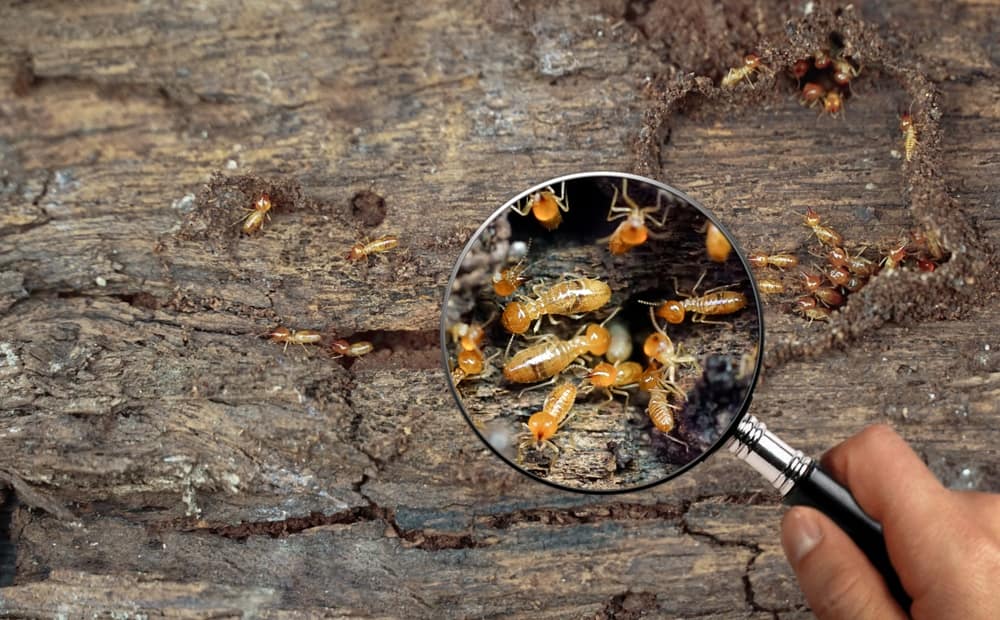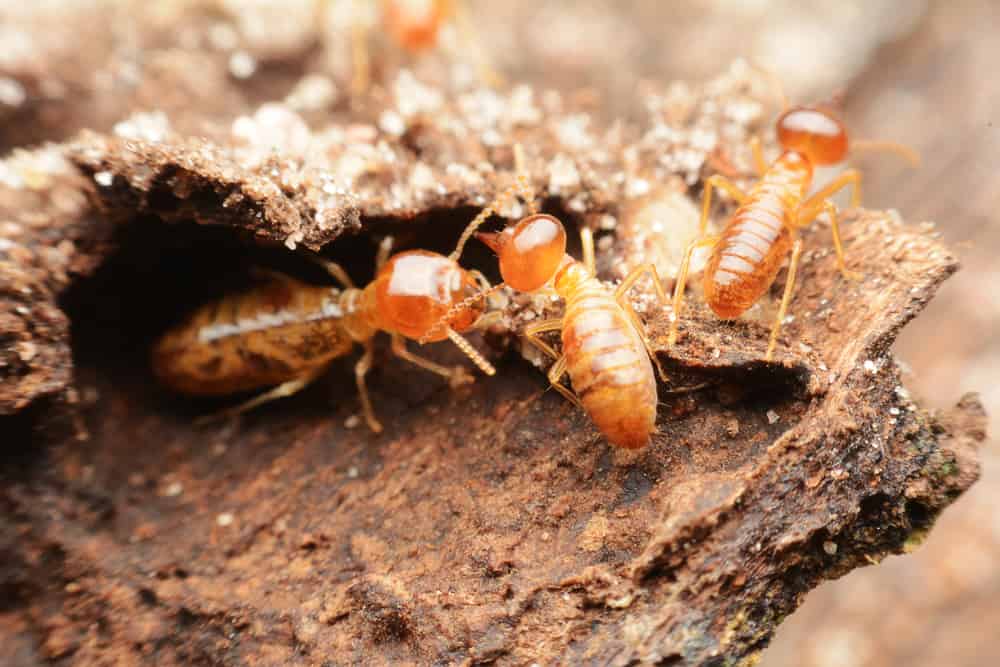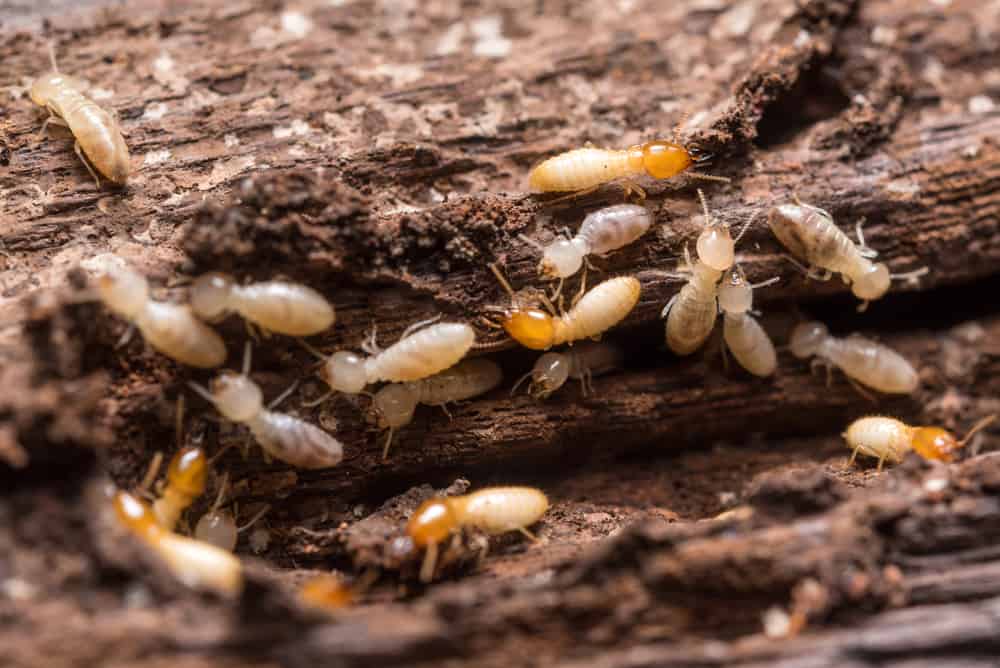
Termites in Florida are more than just pests; they’re a homeowner’s worst nightmare.
©Oasishifi/Shutterstock.com
Ah, Florida! The Sunshine State, where the oranges are as juicy as the sunsets and where the beaches stretch as far as the eye can see. But amidst the allure of its tropical charm, there lurks a tiny menace that homeowners dread: termites. If you’re sipping your morning coffee in your Floridian home or daydreaming about moving to this sundrenched paradise, it’s time to get acquainted with these woodmunching critters. Let’s unravel the mystery below.
What are Termites?
Termites, often mistaken for white ants, are a group of eusocial insects. Unlike ants, they have a soft body and a straight abdomen. Their primary diet consists of wood, but it’s not just the wood in your home they’re after. Termites play an essential role in nature by breaking down tough plant fibers and recycling dead and decaying trees. This might sound great for the environment, but when they decide your home is their next meal, it’s a completely different story.
Why Florida?
So, why does Florida, of all places, seem to be a hotspot for these critters? The answer lies in its climate. Florida’s warm, humid environment is like a luxury spa for termites. It provides them with the perfect conditions to thrive, reproduce, and, unfortunately for homeowners, munch away. The state’s abundant rainfall and high groundwater levels create an ideal environment for termites to establish their colonies and seek out food, which might just be the wooden beams of your dream home.

Different species of termites thrive in Florida’s warm climate, each bringing its own set of challenges.
©Witsawat.S/Shutterstock.com
Types of Termites in Florida
Florida’s diverse ecosystem and warm, humid climate make it a hotspot for various termite species. Each has its unique characteristics, behaviors, and preferred habitats. Let’s delve deeper into the primary culprits that Florida homeowners should be aware of.
Subterranean Termites
Often hidden from sight, these termites are aptly named for their preference to live underground. They’re master builders, creating complex networks of mud tunnels, which serve as their highways to food sources and protect them from predators.
Eastern Subterranean Termites
As the most prevalent termite species in North America, these termites have a particular liking for Florida’s sandy soils. While they might not be as aggressive individually, don’t be fooled. Their strength lies in their numbers. A single colony can house hundreds of thousands of termites, all working diligently to feed and support the colony. Over time, this can lead to extensive damage, often hidden behind walls or under floors until it becomes a significant issue.
Formosan Subterranean Termites
Introduced to the U.S. from East Asia, the Formosan termite has earned its reputation as the “super termite.” Not only do they establish colossal colonies, often housing millions, but they also have a voracious appetite. Their ability to consume wood at an alarming rate, combined with their aggressive nature, makes them a formidable foe for any homeowner. Their colonies can penetrate deeper into the ground and spread wider, making them harder to detect and treat.
Drywood Termites
Unlike their subterranean cousins, drywood termites don’t need soil contact. Drywood termites are the freelancers of the termite world, setting up shop directly in the wood they consume.
These termites are also particularly sneaky. They can infest furniture, wooden beams, hardwood floors, and even picture frames. Their colonies might be smaller, but they’re efficient. A single pair of reproductive termites can establish a new colony, leading to multiple infestations within one home.
Over time, drywood termites can hollow out large sections of wood, leaving only a thin veneer intact, which can lead to sudden and unexpected structural failures.
Dampwood Termites
If there’s one thing dampwood termites love, it’s moisture. And in Florida, with its high humidity and frequent rains, they’re in paradise.
Preferring wood with a high moisture content, these termites are often found in decaying logs, tree stumps, and areas with water damage. Homes with poor ventilation, unresolved water leaks, or those located in flood-prone areas are especially at risk. While their colonies are typically smaller than subterranean or drywood termites, their preference for moist wood can lead to other issues, such as mold or fungal growth, compounding the problems for homeowners.
While Florida offers a rich and diverse habitat for termites, understanding these species’ behaviors and preferences can arm homeowners with the knowledge to detect, prevent, and treat potential infestations.
Risks Associated with Termites
Termites, often referred to as “silent destroyers,” pose significant threats to homeowners, not just in Florida but across the U.S. Their insidious nature and relentless appetite for wood can lead to a myriad of problems.
Structural Damage
Termites, especially in large colonies, can wreak havoc on the structural components of a home. Their damage isn’t just limited to aesthetic concerns; they pose real dangers to the inhabitants.
Foundations and Support Beams
Termites primarily target the wooden elements of a structure. In homes with wooden foundations or significant wooden components, termite infestations can weaken the very base of the structure. Support beams, crucial for maintaining the stability of a home, can be hollowed out, leading to sagging floors or ceilings.
Walls and Partitions
Termites can navigate through plaster, metal siding, and more to get to the wooden studs inside walls. Over time, the studs can be weakened, compromising the wall’s strength and stability.
Hidden Damage
One of the most concerning aspects of termite damage is its often hidden nature. Termites can eat away at the inside of wooden structures, leaving only a thin layer intact. This can lead to sudden collapses or failures, posing a risk to the home’s occupants.
Secondary Issues
Termite damage also leads to secondary problems, such as weakened wood, which can become more susceptible to mold and mildew, especially in humid environments like Florida. This not only poses additional repair costs but can also lead to health concerns.
Economic Impact
The financial implications of termite infestations are staggering. Their silent and often unnoticed destruction can lead to significant expenses for homeowners.
Repair Costs
Once termite damage becomes visible, the costs for repairs can be substantial. Replacing structural components, redoing walls, or even just cosmetic fixes can quickly add up. In severe cases, where the damage is extensive, homeowners might find themselves facing the daunting prospect of extensive renovations or even rebuilding portions of their homes.
Treatment Expenses
Addressing a termite infestation isn’t cheap. Depending on the infestation’s extent and the treatment method chosen, homeowners can expect to spend hundreds to thousands of dollars. This includes not only immediate treatment but also follow-up checks and potential retreatments.
Preventive Measures
Savvy homeowners often invest in preventive measures to ward off potential termite infestations. These can include regular inspections, termite barriers, and treatments, all of which come with associated costs.
Decreased Property Value
Homes with a history of termite infestations will likely see a decrease in their market value. Potential buyers might be wary of latent damage or the prospect of future infestations, leading to reduced offers or prolonged listing times.
In short, while termites might be small, the risks they pose are anything but. Homeowners should be vigilant, proactive, and informed to protect their homes and wallets from these persistent pests.

While they may seem harmless, a termite colony can consume a pound of wood a day!
©BEJITA/Shutterstock.com
How to Prevent Termites in Florida
Florida’s warm and humid climate is a haven for termites, but with the right preventive measures, homeowners can significantly reduce the risk of an infestation. Here’s a more in-depth look at some of the best strategies to keep these wood-munching pests at bay.
Regular Inspections
While homeowners can conduct basic checks, hiring a professional pest control service for annual or bi-annual inspections can make a significant difference. These experts have the training and tools to spot early signs of an infestation that might be easily overlooked.
Here are a few key signs to watch for:
Mud Tubes
These pencil-thin tunnels, often found on exterior walls, are a clear sign of subterranean termites. They use these tubes as protective highways between their underground colonies and their food sources.
Discarded Wings
After swarming and mating, termites shed their wings. Finding a pile of these near windows or other entry points can indicate a recent termite invasion.
Hollow-Sounding Wood
Tapping on wooden structures can reveal hidden damage. If it sounds hollow, it might be because termites have been feasting on the inside.
Reduce Moisture
Florida’s humidity is a magnet for dampwood termites and even subterranean species. Managing moisture is crucial.
Ventilation
Ensure crawl spaces, attics, and basements have adequate ventilation. This helps in reducing the buildup of moisture, making the environment less hospitable for termites.
Address Leaks
Even a minor leak can create a moisture-rich environment that termites love. Regularly inspect your home for signs of water damage, and address any leaks immediately.
Landscaping Tips
Ensure that the ground slopes away from your home’s foundation to prevent water accumulation. Also, avoid over-mulching garden beds or placing mulch too close to wooden structures.
Wood-Soil Contact
Termites can easily bridge the gap from the soil to wood if they’re in direct contact. Ensure there’s a gap between any wooden parts of your home and the ground. This includes steps, decks, and even wooden siding.
Use Termite-Resistant Materials
With termites being such party crashers in the Sunshine State, it’s essential to pick materials that keep them off the guest list. From the heart of a tree to modern marvels, here’s a rundown of termite-resistant materials that combine strength, beauty, and peace of mind.
Heartwood
This is the dense inner part of a tree trunk, and it’s naturally more resistant to termites than the outer sapwood. If you’re sourcing timber for construction, consider using heartwood, especially for foundational elements.
Composite Materials
Modern construction often uses composite materials, which blend wood with other elements, making them less appealing to termites. They offer the aesthetic appeal of wood without the vulnerability.
Treated Wood
Wood that’s been treated with specific chemicals can deter termites. This can be especially useful for foundational elements or areas where wood might come into contact with the ground.
Metal Framing
For those looking to avoid wood altogether, steel framing is an option. Termites can’t eat metal, making this a long-lasting and termite-proof choice.
While Florida’s climate might be a dream for termites in Florida, homeowners aren’t defenseless. With regular inspections, moisture management, and the right construction choices, it’s entirely possible to live in the Sunshine State without the constant worry of these pesky invaders.
Sun, Sand, and Safeguarding: The Floridian’s Guide to a Termite-Free Paradise
Florida, with its shimmering beaches, lush landscapes, and vibrant culture, is undeniably a dream destination for countless individuals. However, beneath its picturesque surface, it’s also a haven for termites in Florida. These tiny invaders, if left unchecked, can transform the dream of homeownership into a costly nightmare. But it’s not all gloom and doom!
By arming yourself with knowledge about these pests and adopting proactive measures, you can safeguard your home from termite damage. So, as you bask in the Florida sun, sipping on your cool drink, and soaking in the beauty of the Sunshine State, always remember to stay vigilant and keep an eye out for these silent destroyers. After all, a dream home is worth protecting!

Termites are nature’s recyclers, breaking down tough plant fibers, but they’re not so welcome in our homes.
©ChaiyonS021/Shutterstock.com
Termite Troubles in the Sunshine State: Your Top Questions Answered!
Florida, the land of sun, sand, and… termites? As surprising as it might sound, these tiny invaders have made a name for themselves in the Sunshine State. But fear not! We’re here to arm you with knowledge. Dive into our frequently asked questions to become a termite expert in no time!
1. How often should I inspect my home for termites?
Ideally, homeowners in Florida should conduct a basic visual inspection of their homes every few months due to the state’s conducive climate for termites. However, a thorough professional inspection is recommended at least once a year. If you live near wooded areas or have had previous infestations, consider more frequent professional checks.
2. Are there natural ways to repel termites?
Absolutely! Some homeowners swear by natural repellents like vetiver grass, which termites seem to dislike. Essential oils, especially orange oil, have also been known to deter termites. Cedarwood, too, is naturally resistant to termites. However, while these methods can help, they might not offer the comprehensive protection that professional treatments provide. It’s always good to combine natural methods with modern preventive measures.
3. How quickly can termites damage a home?
The speed at which termites in Florida can damage a home varies. Factors include the species of termite, the size of the colony, and the wood’s accessibility. For instance, a large colony of Formosan termites can consume about a pound of wood in a day! So, in just a few months, significant damage can occur, especially if the infestation goes unnoticed.
4. Do all homes in Florida have termites?
While it might seem that way given Florida’s termite-friendly climate, not all homes are infested. However, the risk in Florida is considerably higher than in many other states. It’s said that there are two types of homes in Florida: those that have termites and those that will get them. This adage underscores the importance of regular inspections and preventive measures.
5. Can I treat termites myself?
DIY treatments are available, and some can be effective for minor infestations. However, termites are sneaky pests, and a DIY approach might not address hidden colonies or the full extent of an infestation. Moreover, incorrect treatments can scatter the colony, leading to multiple infestation points. For comprehensive protection and peace of mind, it’s always best to consult with a professional exterminator. They have the tools, knowledge, and experience to ensure termites are thoroughly eradicated.
And there you have it – a quick guide to navigating the termites in Florida. Remember, knowledge is your best weapon against these pesky invaders. Stay informed, stay vigilant, and enjoy all the beauty and warmth Florida has to offer, termite-free!
Thank you for reading! Have some feedback for us? Contact the AZ Animals editorial team.







